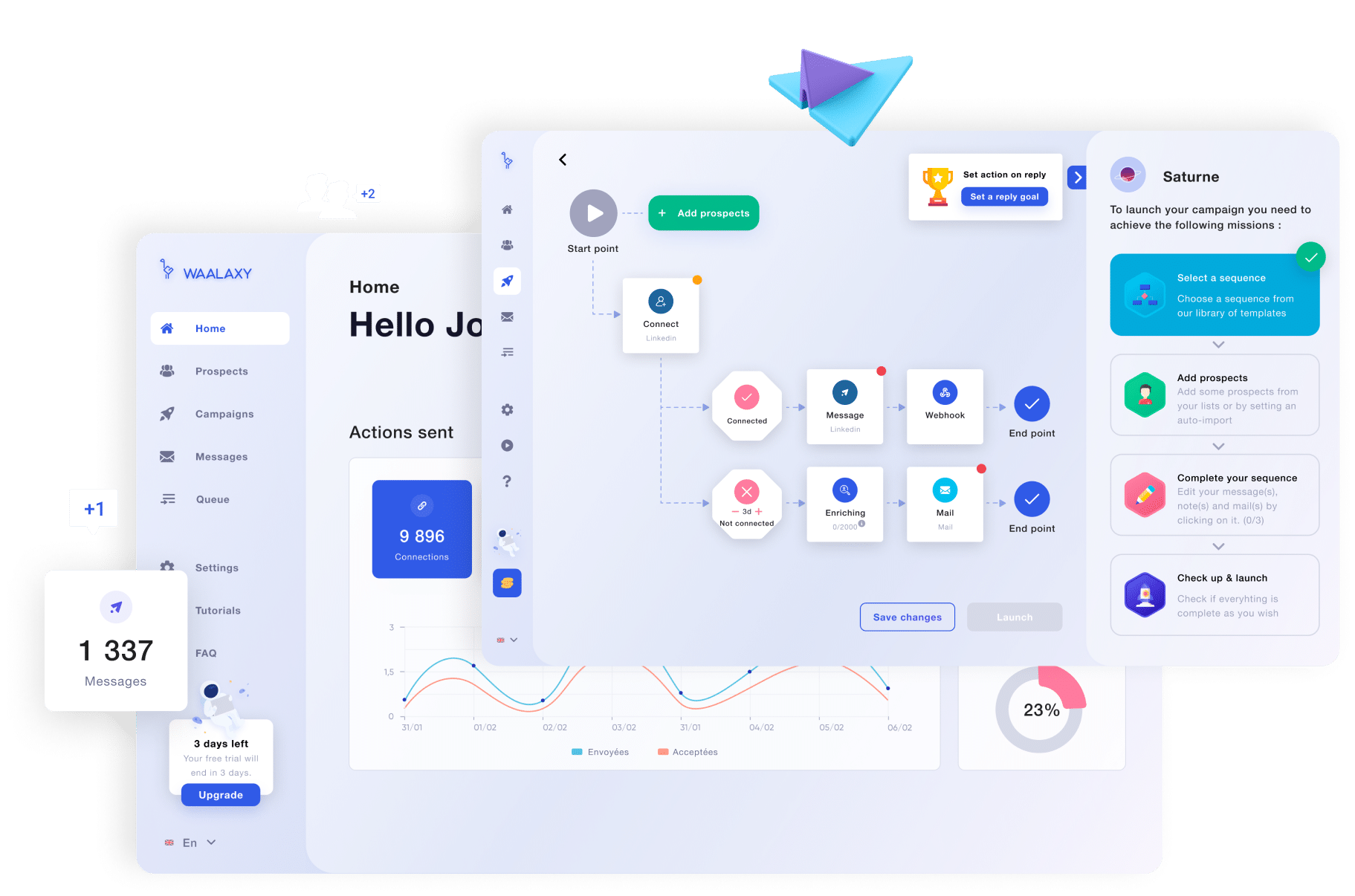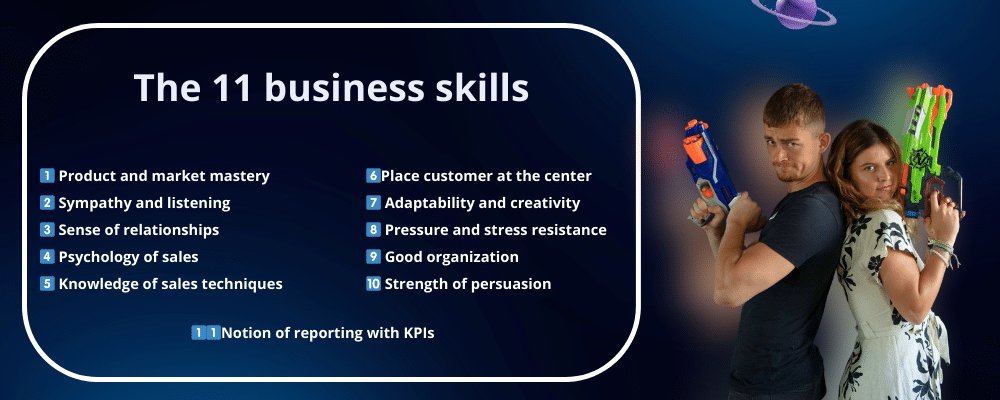If you’re already a salesperson, just starting out in the profession or want to update your sales skills, you’ve come to the right place.
I’ll tell you what the 12 most sought-after qualities are and how to get them.
Are you ready? Let’s get started! 🚀
1) Understanding the product offering and the market
You need to have some knowledge of business to do business. So far so good. But what does that mean? You need to understand your market, its ins and outs, so that you have a global view of what you’re selling.
There’s an old trick 🌍 called Porter’s 5 forces. Basically, you just need to do a little Google search on these topics:
- 1️⃣ The degree of rivalry with competitors: how many are there? Who are the main ones? How good are they?
- 2️⃣ The threat from new entrants: in reality, who cares about the degree of threat? However, if it’s high, going for a walk from time to time will help you to stay ahead of any nasty surprises.
- 3️⃣ The threat of substitute products: What other tools/services can be used instead of yours? These competitors should also be taken into account.
- 4️⃣ The bargaining power of suppliers: It all depends on your market. In supermarkets, for example, a few centimes are negotiated severely between the producer and the buyer, and really make the difference.
- 5️⃣ Customers’ bargaining power: Basically, how much can they get you to lower prices, how much pressure do they have on you?
Generally speaking, a product that sells well but is expensive = high bargaining power, whereas a product that sells well but is cheap = low bargaining power.
2) Be sympathetic and willing to listen
So how can you improve your sympathy capital and listening skills? 🤔
Here are our little tips to use without moderation 🍷 :
- 🟣 Avoid talking too much about yourself, especially your successes. “I’ve been voted best salesperson of the month”, who cares?
- 🔵 Smile, but not with all your teeth, forced smiles show.
- 🟣 Be sincere. It’s stupid, but a salesperson who believes in what they’re selling will always sell better.
- 🔵 Don’t neglect the little gestures, from offering a pen to a 10% discount, everyone loves gifts, and it enhances the customer experience.
- 🟣 Show empathy. When someone comes to see you, usually they have a need or a problem to solve, the more you understand the customer the more they love you. We are narcissistic beings, never forget that.
- 🔵 Don’t pretend to be nice, it shows.
Listening, on the other hand, is essential to understanding the customer’s needs and expectations. In fact, by showing that you value their opinion, you’re going to create an environment conducive to open communication.
Get your first customers this week
Take advantage of the power of Waalaxy to generate leads every day. Start prospecting for free, today.

3) Good interpersonal sales skills
This skill enables professionals to create and maintain strong relationships 🫱🏽🫲🏼 with their customers, colleagues and partners.
It is based on the ability to communicate effectively, show empathy and, above all, make personal connections. Roughly speaking, this means being able to understand and anticipate the needs of others, and therefore, finding solutions that work! 🔥
Finally, it enables productive collaboration within your teams, sharing ideas and optimising problem solving.
4) Good sales psychology
This is an essential skill that goes beyond the simple sales transaction. 👀
It involves understanding deep motivations, fears, but also the desires that influence customers’ buying decisions. It allows salespeople to create more personalised and effective sales strategies, by directly addressing the emotions and specific needs of each customer. 👀
What does it take into account? 🤔
Well:
- Reading between the lines.
- Interpreting non-verbal cues.
- Picking up on innuendo.
- Active listening.
- Deep empathy.
- Ability to quickly establish a relationship of trust.
As you can see, good sales psychology involves understanding group dynamics and the social influences that can affect buying decisions.
5) Knowledge of sales skills
This knowledge requires you to know the different strategies and methods for persuading and closing sales.
There are two main techniques: 👇🏼
- 🥇 Consultative selling: focusing on creating a relationship of trust with the customer to identify their needs and propose suitable solutions/
- 🥈“Closing“: knowing when and how to ask for the sale, confidently overcoming the customer’s objections.
6) Putting the customer at the centre of sales techniques
for this sixth sales skills, putting the customer at the centre of sales techniques requires salespeople to create a personalised experience for each customer that will increase customer satisfaction and loyalty. 💟
This requires listening to the customer, asking relevant questions to identify 🔎 their needs, and providing solutions that add real value to their situation.
However, this technique requires great flexibility on the part of the salesperson because, consumer expectations are constantly changing. 📈
7) Sales skills : Adaptability and creativity
Your prospects are going to say no to you. They’ll say no and they’ll never say yes, and sometimes they’ll say they’re not interested, but they’ll end up agreeing to find out more, if you know how.
These are called sales objections.
- 💢 Immediate rejection or evasion: “I’m not interested” or “I’m not the one to deal with that”.
- 💢 Competition: “I already use your competitor’s product and I don’t want to change”
- 💢 Time: “I don’t have time” “call me back in 3 months”
- 💢 Price: “It’s too expensive”, “I’ve found it cheaper elsewhere”
- 💢Features / options: “It doesn’t have what I’m looking for”
- 💢 Confidence: “I prefer a brand I know better” “I’m not convinced”
How do you respond to commercial objections?
For each type of objection, there’s a negotiation method for responding. I’m not telling you that it always works, I’m just saying that it’s your best card 🗺️ to play if you want to prospect successfully.
There are several options available to you: 👇🏼
- Break down the price and explain it.
- Highlight the features to justify the price.
- Minimise the price, by relating it to the monthly cost or explaining that it will save you money in the long term.
- Check the need. If it’s too expensive forthe customer, it may not meet a strong need.
🅰 If you don’t have the answers, stay honest and let the prospect move on. Being a good salesperson also means accepting that you won’t make a sale.
8) Resistance to pressure and stress
Being a salesperson is generally stressful because you have sales targets to reach and you work on rewards.
Some sites will tell you that you need to be “stress resistant”, I hate that expression. Nobody is stress resistant, we’re not building materials, we’re humans. 💟
The best thing I’ve found to reduce my stress is to accept my emotions. Yes, it’s very cliché, I admit. (Ah and I have a stress ball too). 🧸
All the books, podcasts and sites will tell you the same thing:
- 1️⃣ Meditate before going to sleep.
- 2️⃣ Take time to listen to your emotions.
- 3️⃣ Give yourself time away from your work phone.
9) Good organisation (CRM)
A customer relationship management (CRM) system is a great way to get organised, as it centralises customer information and provides a 360° view of every interaction, transaction and preference.
In fact, you’ll be able to see 👀 the history of communications, specific needs and sales opportunities, what more could you ask for? 😇
If you don’t know what a CRM is, it’s a tool that improves productivity by automating repetitive tasks such as data entry, follow-up reminders or even marketing campaign management.
Here’s a small example of what a CRM can do in relation to sales: ⬇️
| CRM functionality | Example |
|---|---|
| Contact management | Centralises customer contact information for quick and easy access. |
| Interaction tracking | Record the history of calls, emails and meetings with each customer for personalised follow-up. |
| Sales opportunity management | Identify and track promising leads through to conversion into sales. |
| Sales analysis | Analysis of sales data to identify trends, measure campaign performance and adjust sales strategies. |
10) Sales skills : Persuasiveness
Persuasiveness is based on the ability to communicate clearly and convincingly.
In other words, responding directly to the customer’s needs and desires. 😇 To do this, you need to have a thorough understanding of the customer’s motivations.
You can, for example, use psychological techniques such as social proof, scarcity or even a sense of urgency! 🔥
You’ll then be able to increase sales, but also build a lasting relationship with your customers, based on trust. 👀
11) Reporting with KPIs
Sales activity can be defined as all the company’s activities aimed at maintaining, developing or creating commercial relationships with its customers. Marketing skills, on the other hand, are more digital. They will be linked to everything to do with “performance measurement”. 📊
Basically, to be a successful salesperson, it’s not enough to make sales, even if that’s already great, you’re going to have to analyse: 👇🏼
- The number of successful sales over a given period,
- The number of unsuccessful sales over the same period and identify the obstacles to purchase,
- Calculate your customers’ average basket: yes, you sell, but what do they buy and how much?
- The customer satisfaction rate. A happy customer returns, so has he enjoyed his sales journey?
- The turnover you’ve managed to achieve,
What are the most common calculations used to analyse commercial prospecting? ⬇️
- The number of appointments made: separate telephone and face-to-face appointments.
- The number of new qualified leads generated over a given period.
- Rate of requests for quotes: (Number of quotes sent / Number of people contacted x100).
- Demo rate: (The number of product demonstrations carried out / number of people contacted).
- Rate of successful demos: (The number of product demonstrations carried out / the number of quotes sent x100).
- Conversion rate.
- Sales generated over the given period.
How about a quick recap of sales skills ?

🧠 The skills and soft skills we’re really looking for are :
- Adaptability. How do you bounce back from failure?
- Your perseverance and motivation. A motivated salesperson is the first thing recruiters look for.
- The sympathy and confidence you inspire.
- Your skills in software management and CRM (Customer relationship management), as well as your ability to produce reports and analyse KPIs.
- Your past experience and successes. Recruiters want figures. Have you sold well?
- Your understanding of the market in which you are applying. Have you done any research? What is its market share? Do you understand your future employer’s objectives and goals?
✅ Prepare for your interview, learn as much as you can about the products you are going to sell. You’re going to be tested on them.
Frequently asked questions
Don’t rush off, we still have a few resources to share with you. 😇
What are commercial skills?
A sales skill refers to all the knowledge, skills and behaviour that enable a salesperson to sell products or services effectively. It takes into account: 👇🏼
- The ability to understand customers’ needs and desires.
- Clearly communicating the benefits of a product or service.
- Converting prospects into customers.
- Negotiating the terms of the sale.
- Closing deals.
- Build lasting relationships with customers.
What skills should be included on a sales CV?
You can add the following to your sales CV:
- 🟣 Empathy.
- 🟣 Listening skills.
- 🟣 Tenacity.
- 🟣 Team spirit.
- 🟣 Customer relationship management.
- 🟣 S ales management.
- 🟣 Spoken languages.
- 🟣 Prospecting tools you are familiar with.
Then add all your professional experience:
- 🔵 X sales in such and such a company.
- 🔵 Portfolio of X clients.
- 🔵 Development of X market.
- 🔵 Increase turnover by X€.
- 🔵 Average basket increased by X%.
- 🔵 Implementation of sales strategy in X company.
- 🔵 Automated prospecting for X prospects.
There is a totally free online tool that allows you to easily create your CV, it’s called CVDesigneR.
And there you have it, you know all about the sales skills you need to have! ⭐️






